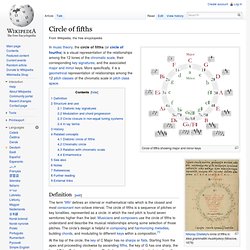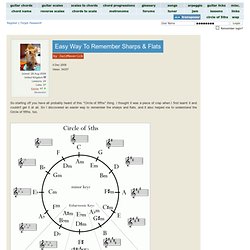

Universal property of music discovered. Researchers at the Institute for Logic, Language and Computation (ILLC) of the University of Amsterdam have discovered a universal property of musical scales.

Until now it was assumed that the only thing scales throughout the world have in common is the octave. The many hundreds of scales, however, seem to possess a deeper commonality: if their tones are compared in a two- or three-dimensional way by means of a coordinate system, they form convex or star-convex structures. Convex structures are patterns without indentations or holes, such as a circle, square or oval. Almost all music in the world is based on an underlying scale from which compositions are built.
In Western music, the major scale (do-re-mi-fa-sol-la-ti-do) is the best known scale. 1000 scales By placing scales in a coordinate system (an 'Euler lattice') they can be studied as multidimensional objects. The research results were recently published in the scientific Journal of New Music Research. 6 Essentials to Master the Blues. Photo from Flickr Blues is one of the most important things to learn when you want to become a rock – jazz – metal – country – all round guitar player All these genres are related to or arisen from the blues.

There is also a lot of blues in the songs you hear on the radio without even realizing it. It’s hard to be a great rock n’ roll guitar player without learning the blues first. Okay maybe you can, but you will probably sound like crap. :-) Blues is what makes your guitar cry, shiver and scream. It’s got anything you need to express your feelings. Here are the 6 essentials to master the blues. 1. 2. 3. 4. 5. 6. “I’ve said that playing the blues is like having to be black twice. If you like this post, please share it on Stumbleupon. De Fascinatie. Gypsy scale.
The term Gypsy scale,[a] refers to one of several musical scales named after their association with Romani or stereotyped "Gypsy" music: Hungarian minor scale, minor scale with raised fourth and seventh degrees, also called double harmonic minor scale.Minor gypsy scale, minor scale with raised fourth but natural seventh. [1] Both these scales are also called Hungarian gypsy scale.Spanish Gypsy scale, another name for the Phrygian dominant scale. [1][2]Double harmonic scale, the fifth mode of the Hungarian gypsy scale. [3] Notes[edit] References[edit]

Learning and Loving Music Theory - StumbleUpon. Kelvin, You actually caught a mistake on the roman numerals!

Thanks, I’ll have to fix that. The first and last chords of the progression are not 7th chords. Forums : Off-topic Discussion : Music Theory- The basics updated V7. Introduction Hello there, you may have seen me around The Escapist and most know me as The Rockerfly, I am a musician. I have been playing music for about 10 years and have been writing for 3 years. I have an A level in music, grade 7 guitar, grade 5 in tuba, play the drums part time and sing for a group as well. It has come to my attention though that several Escapist members wish to become musicians or are in the process of becoming musicians and this guide is here to help you on your journey. Music Cognition Lab - Psychology Department - Tufts University. Interactive Circle of Fifths User's Guide. A Jazz Improvisation Primer. This is the online version of my text, A Jazz Improvisation Primer.

Here you can find information on almost every topic relating to jazz improvisation, from jazz history to music theory to practical advice on playing in a group. A German translation, by Edgar Lins, is online, at There is also a Hungarian translation at provided by Makrai Balázs. A Portuguese translation by Cláudio Brandt can be found at And now there is a French version at Portions of this text are available in Italian, courtesy of Roberto Betti, at. Circle of fifths. Circle of fifths showing major and minor keys Nikolay Diletsky's circle of fifths in Idea grammatiki musikiyskoy (Moscow, 1679) In music theory, the circle of fifths (or circle of fourths) is a visual representation of the relationships among the 12 tones of the chromatic scale, their corresponding key signatures, and the associated major and minor keys.

More specifically, it is a geometrical representation of relationships among the 12 pitch classes of the chromatic scale in pitch class space. Definition[edit] Structure and use[edit] Easy Way To Remember Sharps & Flats. So starting off you have all probably heard of this "Circle of fifths" thing.

I thought it was a piece of crap when I first learnt it and couldn't get it at all. So I discovered an easier way to remember the sharps and flats, and it also helped me to understand the Circle of fifths, too. So, for the sharps, I'll name the keys in order of how many sharps there are. Key of G = 1 sharp Key of D = 2 sharps Key of A = 3 sharps Key of E = 4 Sharps Key of B = 5 Sharps Key of F# = 6 Sharps Key of C# = 7 Sharps Now, to remember this, I used words for each Key letter and it became a story. Goes Down And Ends Battle, Father Charles Now, to remember the order of the sharps that are in each key I'm using the same words for each, like so: Father Charles Goes Down And Ends Battle.
Just incase you don't get this, F# is the only sharp in the key of G. Pretty much the same thing for the Flats, too. Key order: Father's Battle Ends And Down Goes Charles. Scale Theory Chart. Bill Robinsons Music Theory Thread - Jazz Bulletin Board. Outline of basic music theory - www.oscarvandillen.com.